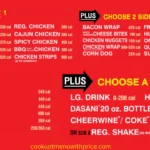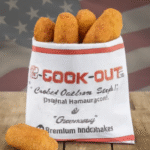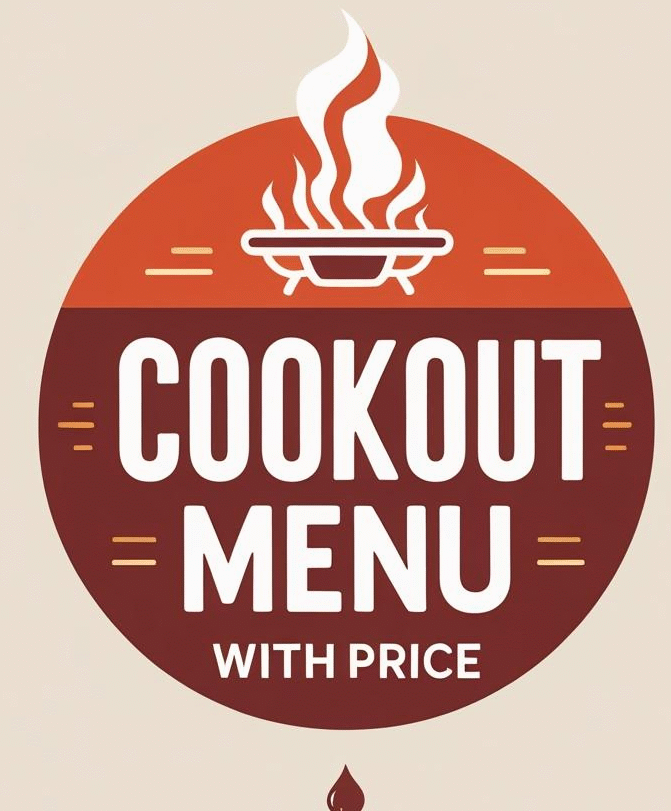Cook Out Allergen Menu
Are you one of the many Cook Out fans who love the thrill of customising your tray or milkshake, but dread the uncertainty that comes with food allergies or dietary restrictions? The fear of cross‑contamination, hunting for up‑to‑date allergen information, and wondering which items you can safely enjoy can turn what should be a fun meal into a stressful guessing game.
Imagine confidently placing your order and payment, fully aware of every ingredient, preparation step, and safe customisation option.No more second‑guessing or scanning outdated charts, just a seamless, delicious cookout experience tailored to your needs.
This guide is your bridge to that peace of mind. To learn more about Cook Out careers, we’ve meticulously gathered and analysed Cook Out’s official allergen data, spoken directly with restaurant staff, and tested custom orders to bring you clear, actionable advice.
By the end of this Ultimate Allergen Menu Guide, you’ll have:
- A step‑by‑step process for using Cook Out’s allergen resources
- An understanding of common cross‑contact risks in the kitchen
- A curated list of naturally safe menu items and smart customisation tips
- Confidence‑boosting strategies for ordering in‑restaurant or via third‑party apps
Consider a Cook Out gift card to savour every bite without compromise. Let’s get started on making that worry‑free Cook Out meal a reality.
1. Accessing the Official Allergen Information
- Visit the Cook Out Menu Page.
- Go to cookout.com/menu and look for “DOWNLOAD NUTRITION FACTS.” This is your gateway to allergen details
- Download the Nutrition & Allergen PDF
- Click Download Nutrition Facts to open the PDF, July 202.5. This document includes both nutritional values and allergen indicators.
- Use the Cook Out Mobile App (if available).
- Open the official Cook Out app, tap Menu, then Nutrition & Allergens. The interface mirrors the website PDF for consistency.
Quick Tip: On the website, use Ctrl + F and search keywords like “wheat,” “soy,” or “eggs” to jump straight to the allergen you’re tracking
Understanding Official Disclaimers & Warnings
- You’ll often see phrases like “prepared on shared equipment with wheat products.” This highlights cross‑contact risk.
- Indicates trace amounts could be present. Critical for those with anaphylaxis-level allergies.
- Even microscopic allergen traces can trigger severe reactions. Treat every warning as essential, not optional.
Interpreting the Allergen Chart
- A ✓ under Milk, for example, means the item contains dairy; a blank box means it does not.
- Look for numbered notes at the bottom of each table, which clarify if an ingredient change or preparation method affects allergen presence.
- Always compare the main table with the footnotes. An unmarked item may still carry a footnote indicating “contains trace soy.”
All data in this guide is pulled directly from Cook Out’s official Nutrition & Allergen PDF, last verified July 2025. We continually monitor Cook Out’s website for updates to ensure you have the freshest, most trustworthy information.
This comprehensive table provides a quick reference for everyday Cook Out menu items and their major allergen content
| Menu Item | Allergen | Notes/Customisation |
| Cook Out Style Burger (Bun | Milk, Eggs, Peanuts, Tree Nuts, Fish, Shellfish | Fried, contains milk, egg, wheat (gluten), soy—high cross-contamination risk in the shared fryer. |
| Hamburger Steak Plate (No Gravy) | Milk, Eggs, Peanuts, Tree Nuts, Fish, Shellfish, Wheat, Soy,Gluten | Patty only. Gravy contains wheat/gluten. Sides vary greatly. |
| Chicken Breast Fillet Sandwich | Peanuts, Tree Nuts, Fish, Shellfish, Wheat, Soy | Bun contains wheat/gluten. Request no bun or lettuce wrap for gluten-free. Patty is typically GF. |
| Chicken Strips | Milk, Eggs, Peanuts, Tree Nuts, Fish, Shellfish, Wheat, Soy, Gluten | Fried chicken contains milk, egg, wheat (gluten), and soy. No easy GF/DF option for fried chicken. |
| Hot Dog (Bun) | Milk, Eggs, Peanuts,Tree Nuts, Fish, Shellfish | Fried, contains milk, egg, wheat (gluten), soy. High cross-contamination risk in the shared fryer. |
| Corn Dog | Peanuts,Tree Nuts, Fish, Shellfish | Contains milk, egg, wheat (gluten), soy. Fried. |
| Cheerwine Float | Eggs, Wheat, Peanuts, Tree Nuts, Fish Shellfish, Gluten | Contains milk (ice cream) and soy (in some soft serve). |
Cook Out Allergen Menu Breakdown: Major Allergens & Gluten
For details on Cook Out’s bacon wrap and other menu items, consult our comprehensive table listing everyday Cook Out menu items, indicating the presence of major allergens and gluten, with a column for essential notes or customisation tips.

Common Cross‑Contamination Risks at CookOut
Shared Fryers
- Risk: Fries, chicken strips, corn dogs, and other battered or breaded items are often cooked in the same oil.
- Allergens at stake: Gluten (wheat), Milk, soy, egg.
- Expert Tip: Always ask your server, “Are fries cooked separately from breaded items?” If not, consider choosing a non‑fried alternative.
Shared Prep Surfaces & Utensils
- Risk: Burger buns, sandwich toppings, and salad ingredients are prepped on the same counters. Crumbs or spillover condiments can transfer allergens.
- Mitigation: Politely request fresh gloves and a clean prep area. Say, “Could you change gloves and wipe down the workstation before assembling my order?”
Milkshake Machines
- Risk: A single machine arm or spindle whips up multiple flavours of chocolate, peanut butter, Oreo, etc. Nuts, dairy, and soy residues can cling to mixing implements.
- Expert Tip: If you have a nut allergy, avoid shakes with nut mix‑ins unless the machine has been thoroughly flushed and wiped. Simpler flavours (vanilla or fruit‑only) typically pose a lower risk.
Mitigation Strategies for Diners
Mitigation Strategies for Diners
- Choose Simpler, Less Customised Items
- The fewer mix‑ins and special request areas involved, the lower your risk. A plain grilled burger or a fruit‑only shake reduces cross‑contact opportunities.
- Opt for Grilled over Fried
- Grilled burgers and chicken aren’t cooked in fryer oil; sidestepping is the most significant shared‑oil hazard.
- Specify Special Preparation
- Don’t hesitate to ask:
- “Can my burger be cooked on a separate part of the grill?”
- “Could you use a fresh utensil/plate for my order?”
- For specific Cook Out location details, call ahead or use mobile notes if you’re ordering for pickup, include a clear allergy note in the app or inform the restaurant by phone.
By understanding how Cook Out’s kitchen operates, shared fryers, prep surfaces, and milkshake machines, you can take targeted actions that dramatically reduce your cross‑contamination risk. These expert strategies empower you to enjoy a safe, satisfying meal every time.
Dedicated Guides for Specific Dietary Needs
Gluten‑Free Options at Cook-Out
Safe Bet Meal Combinations:
- Protein: Burgers or chicken fillets wrapped in lettuce (confirm that the patty contains no wheat fillers).
- Grilled Choices: Grilled chicken sandwich sans bun (ask if marinade or seasoning contains gluten).
- Sides: Side salad (hold croutons; choose oil‑and‑vinegar or a vinegar‑based dressing).
- What to Avoid:
- All fried items (breading), buns, hush puppies, onion rings, corn dogs, and gravy.
- Expert Tip: Always ask the cashier or manager for the latest ingredient list, as recipes can change without notice.
Dairy‑Free & Vegan Choices
- Many menu items and batters include Milk, butter, or egg. Shared fryers may pose cross‑contact risks.
- Fries: Verify that the oil is vegetable‑only and not shared with dairy‑battered items.
- Salad: No cheese, no creamy dressings, stick with oil and vinegar.
- Beverages: Sweet Tea or unsweetened Tea.
- Plain Burger Patty: Order without bun, cheese, or mayo (confirm patty ingredients).
- What to Avoid: Milkshakes, cheese, most sauces (many contain dairy or egg), fried foods (often coated), and coleslaw (may contain dairy).
- Expert Tip: For reassurance, request to see the allergen binder or ask about fryer protocols.
Vegetarian Selections
- Unfortunately, there’s no dedicated veggie burger on the main menu, but there are sides to the rescue!
- Potential Custom Orders:
- Grilled Cheese: If available, verify that the bread and cheese are free from animal‑derived enzymes or additives.
- Double‑Up on Sides: Pair fries (if oil‑verified) with a side salad.
- Milkshake Hack: Order a vanilla shake (contains dairy) if you tolerate lactose, or swap ice cream in a float with a dairy‑free soda for a creamy treat.
- What to Avoid: Anything with bacon bits, meat broths, or sauces containing hidden animal products.
- Expert Tip: Don’t hesitate to customise: ask if they can grill a plain bun for you to assemble a DIY grilled cheese or veggie “sandwich.”
Before stepping up to order, take a breath. This guide is your roadmap. After using these pointers, you’ll bridge the gap between uncertainty and a meal you can genuinely enjoy stress‑free.
Mastering Cook Out Milkshakes Safety & Customisation
Understand the Base Ingredients
- Dairy & Soy: All milkshake bases use dairy ice cream and Milk; most also include soy lecithin as an emulsifier.
- Egg Potential: Some seasonal or speciality flavours (e.g., custard‑style or eggnog shakes) may incorporate eggs. If you have an egg allergy, always double‑check before ordering.
Be Aware of High‑Risk Mix‑Ins
- Peanuts & Peanut Butter: Found in Reese’s and some Snickers mixes.
- Tree Nuts: Pecan swirl, almond crunch, and certain candy bar add‑ins.
- Wheat/Gluten: Oreos, cookie dough chunks, and cheesecake bits all contain gluten.
- Soy in Syrups & Candies: Chocolate syrups, caramel sauces, and many candy pieces contain soy lecithin.
Mitigate Cross‑Contamination
- Request a “Clean” Spindle or Blender: Ask staff if they can rinse or switch to a dedicated spindle (though policies vary by location).
- Use Sealed Cups: If available, ask for a fresh cup straight from the package and your mixing spindle.
- Consider Mix‑In on the Side: Have candy or cookie bits served separately so you can sprinkle what’s safe or choose to skip them entirely.
Safer Customization Strategies
- Stick to Simple Bases: Vanilla, strawberry, or chocolate without added mix‑ins is your safest bet.
- Fruit-Only Additions: Opt for fresh or frozen fruit blends (e.g., strawberry) instead of nut- or gluten-laden toppings.
- Non-Dairy Alternatives: Some locations offer soy- or almond-milk bases. Ask if those are stocked and how they handle cross-contact.
Hidden Gems & Vegan‑Friendly Options
- “Mock” Milkshakes: Order a fruit smoothie (e.g., peach or strawberry) blended with non-dairy milk for a shake-like treat.
- Allergen‑Friendly Flavors: Seek out simple sorbet‑style fruit “shakes” when in season.
- DIY Mix‑Ins: Bring your allergy‑safe mix‑ins (pre‑sealed nuts or allergy‑friendly cookies) and add them yourself after the shake is poured.
By arming yourself with knowledge of common allergens, advocating for clean equipment, and exploring less obvious but still delicious options, you’ll transform the milkshake experience from risky to relaxing. Now, go forth and sip safely!
Planning Your Visit & Ordering Safely
Walking into a busy CookOut or tapping through their app when you have food allergies can feel like tiptoeing through a minefield. Will your meal arrive as requested? Could hidden ingredients or cross‑contact turn a fun night out into an emergency? It’s natural to feel anxious and second‑guess every bun, topping, and fry.
Imagine confidently clicking “Place Order” or handing your order to the cashier, knowing you’ve done everything possible to keep yourself safe. You arrive, pick up your tray, double‑check your dish, and settle in, relaxed, excited, and ready to enjoy every bite without worry.
Follow these proactive steps to transform uncertainty into assurance:
Pre‑Visit Preparation
- Bookmark and revisit Cook Out’s official Allergen Guide before every trip; third‑party sites can be outdated.
- For life‑threatening allergies, call your chosen cookout location 24–48 hours in advance to confirm their protocols and ask about cross‑contact controls.
- Scan the full menu online or in the app, noting naturally safe items and those requiring tweaks.
Communicating with Staff
During Your Meal
- Check your order immediately to confirm bun swaps, sauce omissions, or grilled vs. fried requests.
- Stay mindful of airborne allergens (like sesame seeds in the kitchen).
- Expert Tip: Carry your emergency medications (EpiPen, antihistamines) and review your action plan before you sit down.
Safe‑Bet Combinations & Customisations
- Gluten‑Free Burger: Grilled hamburger patty + lettuce “bun” + plain grilled onions + side of seasoned fries (double‑checked for separate fryer).
- Dairy‑Free Chicken: Char‑grilled chicken sandwich (no cheese) + barbecue sauce (confirm no hidden dairy) + fruit cup.
Build Your Safe Cookout Meal
Ask yourself (or your staff) these questions to create your perfect, worry-free plate
- What are my specific allergens?
- Which menu items are naturally free of these?
- What customisations can I request? (e.g., no bun, no cheese, grilled vs. fried)
- What cross‑contamination risks exist?
- Can staff accommodate extra precautions? (fresh gloves, clean prep area)
Note: When ordering online, look for the “Special Instructions” field (screenshot placeholder) to enter your allergy details directly. This little box can be your best defence against hidden risks.
By following these steps, regular verification, clear communication, and personal vigilance, you’ll transform uncertainty into safe, enjoyable cook-out dining experiences.
Dining out with food allergies can feel stressful, worrying about hidden ingredients, cross‑contact, or miscommunication can turn a crave‑worthy meal into a sleepless night.
Armed with the right tools, official allergen guides, clear staff communication techniques, and simple pre‑planning, you’ll leave Cook Out feeling empowered, safe, and fully satisfied with every bite.
By following the steps outlined in this guide, you transform uncertainty into confidence. Here’s a quick recap to keep top of mind:
- Official Resources Matter: Always consult Cook Out’s latest allergen menu before ordering.
- Cross‑Contamination Awareness: Ask about preparation zones and utensil practices to minimise risk.
- Empowered Communication: Use precise, specific phrasing when talking to the crew: “I have a peanut allergy; could you please change gloves and use a clean spatula?”
- Pre‑Planning Is Key: Review your choices in advance, customise with allergy‑friendly swaps, and, if possible, call ahead to let staff know your needs.
With these strategies, you can confidently explore Cook Out’s tasty, customizable offerings from flame‑grilled burgers to speciality trays, knowing that your safety comes first.
Your Turn: What are your tried‑and‑true “safe” orders at Cook Out? Share your favourites and tips in the comments below. For local guides and tips your insights help keep our allergy community thriving!



